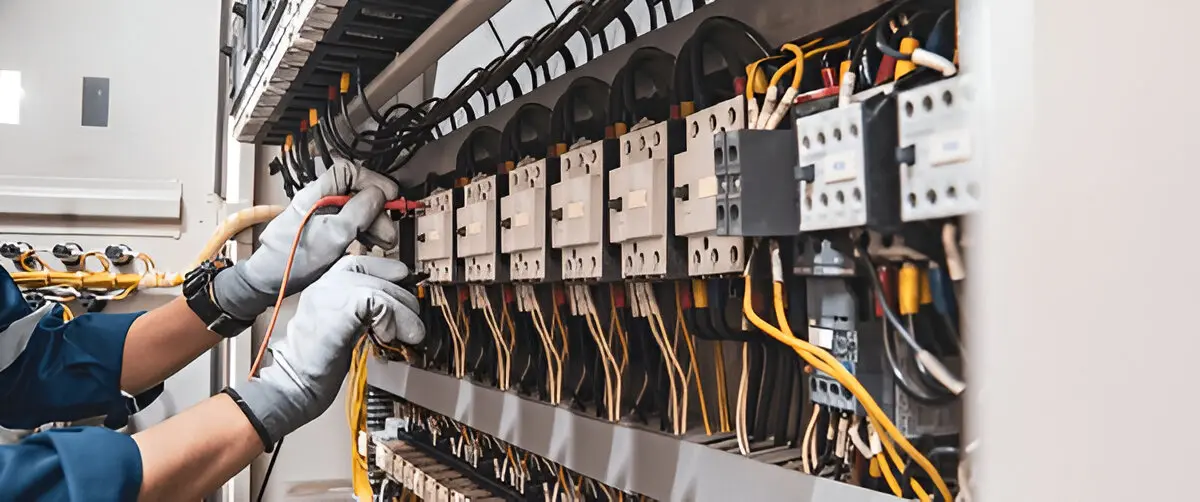How often do we use electricity? Turning on lights, running appliances, or charging your phone—the list goes on. But do you ever think about how the power safely reaches your home? That’s where the discussion about the electrical panel starts.
There is definitely an electrical panel in your home that handles and sends power to different circuits. It is the heart of the electrical system. You might be upgrading an old breaker box or installing a new system; understanding different types of electrical panels will help you choose the right one for your power needs.
In this guide, we’ll explain how electrical panels work, all the varieties, and how to ensure a safe and reliable panel setup for your home or business.
What Is an Electrical Panel?
The center of control of your house’s electrical system is an electrical panel. It distributes power from the utility supply to different circuits, ensuring your lights, appliances, and devices work safely.
Often referred to as a breaker box, it holds fuses or circuit breakers that guard your house against short circuits and overloads. Should a circuit consume too much power, the breaker trips, therefore switching off the current to stop damage or fire.
Although every house and structure has an electrical panel, none are exactly the same. While some are made for industrial power needs or backup generators, others are intended for domestic houses. The key is to pick the correct panel so your house remains safe, effective, and able to meet your power needs.
How Electrical Panels Work
Your electrical panel is the bridge between the utility supply and your home’s circuits. Here’s how it works:
- Power from the Utility Company: Electricity enters your home through a main power line connected to the meter.
- Meter Measures Usage: The electric meter tracks how much power your home consumes.
- Power Enters the Electrical Panel: From the meter, electricity flows into your main breaker panel, where it is distributed to different circuits.
- Circuit Breakers or Fuses Protect the System: These safety devices regulate power flow, shutting off electricity if a circuit overloads or short-circuits.
- Electricity Flows to Circuits: Power travels through wires to different parts of your home, allowing you to use lights, appliances, and outlets.
Understanding Circuit Breakers and Fuses
Every electrical panel has built-in safety features to prevent damage and fire hazards. The two most common are circuit breakers and fuses. Both serve the same purpose—to cut off electricity when excess electricity runs through a circuit—but they work differently.
| Feature | Circuit Breakers | Fuses |
| Function | Trips to cut power | Melts to stop electricity |
| Reset | Can be switched back on | Needs to be replaced |
| Safety | More advanced protection | Works but is outdated |
| Found In | Modern homes & buildings | Older homes & outdated panels |
Major Types of Electrical Panels and Their Functions
A main breaker panel is the primary electrical control system in a home or business. It distributes power from the utility company to different circuits and includes a main breaker, which acts as the system’s on/off switch.
Every property with an electrical system requires a main breaker panel to control power. The main breaker protects against overloads and short circuits by shutting off electricity when too much power flows through the system.
A subpanel is a smaller electrical panel connected to the main breaker panel. It distributes power to specific areas of a property without increasing total power capacity. Large homes and businesses often need subpanels to supply electricity to garages, basements, home additions, or separate buildings.
About installation, a subpanel requires running electrical wiring from the main panel. The costs vary based on distance, amperage, and labor.
A transfer switch panel is designed to work with backup generators. When the power goes out, the transfer switch redirects electricity from the utility grid to the backup generator. Manual and automatic are the two types of transfer switch panels. For manual transfer switches, someone has to switch the power source physically. Automatic transfer switches detect power loss and switch automatically to backup power.
A load center, also known as a fuse box panel, was the standard electrical panel in older homes before circuit breakers became common. Fuses blow when overloaded, which requires replacement. These are outdated now as they lack modern features, are inconvenient, and can’t handle today’s electrical demands.
Smart panels bring automation and energy efficiency to modern homes. With these particular settings, homeowners can monitor and control power usage through a smartphone app. Some features of smart panels:
- Remote Monitoring – Check your home’s power usage anytime, anywhere.
- Automation – Turn circuits on/off remotely.
- Energy Efficiency – Optimize electricity use to reduce power bills.
Smart panels help manage high energy demand, prevent overloads, and integrate with solar power systems for better efficiency.
Businesses and factories need high-capacity electrical panels to handle large amounts of electricity. What are the varieties?
There are High-Tension (HT) and Low-Tension (LT) panels. The former deals with high-voltage power, common in factories and power plants. The latter manages lower voltage, used in offices, warehouses, and small businesses.
Then, there are Power Control Center (PCC) panels and Motor Control Center (MCC) panels. PCC panels distribute power across an industrial facility. MCC panels control heavy machinery and motors in manufacturing plants.
Certain electrical panels are designed for specific applications, such as outdoor use or power-hungry appliances.
- Outdoor-Rated Electrical Panels
These are built to withstand rain, snow, and extreme temperatures; mostly used for outdoor lighting, pool equipment, and detached structures.
- Panels for High-Power Appliances
These are best for HVAC systems, electric vehicle (EV) chargers, and large machinery. They can prevent overloading by supplying dedicated power to high-demand appliances.
How to Choose the Right Electrical Panel
It’s important that you only get an electric panel that’s compatible with your setup, and here’s what you need to know before choosing one:
Key Considerations When Choosing an Electrical Panel
Your electrical panel should match your power demands while allowing room for future expansion. Here are the three most important factors to consider:
The panel’s amp rating determines how much electricity it can safely manage. Most modern homes require at least 200 amps to support appliances and technology.
If you plan to add new appliances, outlets, or an EV charger, you’ll need a panel with extra circuit capacity.
Smart panels and energy-efficient breakers help reduce wasted power, improving your home’s electricity management.
Comparing Electrical Panel Options
| Panel Size (Amps) | Best For | Supports |
| 100-Amp Panel | Small homes, older homes | Basic lighting, small appliances |
| 150-Amp Panel | Medium-sized homes | Moderate appliance use, HVAC systems |
| 200-Amp Panel | Modern homes (standard) | Large appliances, home additions, EV chargers |
| 400-Amp Panel | Large homes, businesses | Multiple HVACs, heavy-duty appliances, industrial setups |
If you’re upgrading or remodeling, choosing at least a 200-amp panel ensures your system can handle future electrical demands.
When to Upgrade vs. Replace an Electrical Panel
Knowing when to upgrade or replace your electrical panel is crucial for being safe and efficient.
Upgrade Your Panel If:
- You added new appliances (EV charger, hot tub, HVAC).
- Breakers trip frequently due to high power demand.
- You need extra circuits for home expansion.
Replace Your Panel If:
- Your home still has a fuse box or an older type of electrical panel.
- The panel shows signs of damage (burn marks, buzzing sounds, overheating).
- It’s over 25 years old and no longer meets modern electrical codes.
Cost Breakdown of Different Electrical Panels
The cost of an electrical panel depends on its size, features, and how complex it is to install. Here’s a general price breakdown based on panel size and type:
| Panel Type | Amperage (Amps) | Average Cost (Panel Only) | Installation Cost (Approx.) |
| 100-Amp Panel | Small homes, older homes | $300 – $700 | $800 – $1,500 |
| 150-Amp Panel | Medium-sized homes | $400 – $1,000 | $1,200 – $2,000 |
| 200-Amp Panel | Standard for modern homes | $500 – $1,500 | $1,500 – $3,000 |
| 400-Amp Panel | Large homes, businesses | $1,500 – $4,000 | $3,000 – $5,000+ |
| Smart Panel | Remote monitoring and automation | $1,000 – $3,500 | $2,000 – $4,500 |
| Subpanel | Additional power distribution | $300 – $1,000 | $500 – $2,000 |
| Transfer Switch Panel | Works with backup generators | $400 – $2,500 | $1,000 – $3,000 |
Factors That Affect Installation Costs
The total cost of installing or upgrading an electrical panel isn’t just about the panel itself. Here are some key factors that impact pricing:
- Panel Size and Amperage: Higher amperage panels cost more due to increased power capacity.
- Labor Costs: Electricians charge based on panel complexity, rewiring needs, and permits.
- Wiring & Circuit Upgrades: If your home needs additional circuits or updated wiring, installation costs increase.
- Location of the Panel: Installing a panel in hard-to-reach areas or running new wiring can add extra labor costs.
- Permit & Code Compliance: Electrical work must meet local building codes, which may require inspections and permits ($50 – $500).
- Smart Panel Features: Remote monitoring, automation, and energy management add to the cost of modern panels.
Electrical Panel Safety and Maintenance Tips
Common Electrical Panel Issues and How to Fix Them
When you know there’s a problem with the electric panel, you must call an expert electrician. But first, what could be the issues, and how can they be solved? Check the table below for an understanding:
| Issue | Possible Cause | Solution |
| Frequent Tripping of Breaker | Overloaded circuit or faulty breaker | Unplug unnecessary devices; call an electrician if the issue persists. |
| Burning Smell or Scorch Marks | Wiring damage or overheating inside the panel | Turn off the power immediately and contact a professional electrician. |
| Buzzing or Crackling Sounds | Loose connections or faulty breakers | Have a technician inspect and secure any loose wiring. |
| Rust or Corrosion | Moisture exposure weakening connections | Keep the panel dry and replace rusted components as needed. |
| Outdated Fuse Box | Cannot support modern electrical demands | Upgrade to a modern electrical panel for improved safety. |
How to Prevent Electrical Fires and Overloading
- Don’t Overload Circuits – Avoid plugging too many appliances into one circuit. Use dedicated circuits for high-power devices.
- Label Your Breakers – Properly label each circuit in your breaker box to make troubleshooting easier.
- Inspect Your Panel Annually – Check for loose wires, signs of damage, or overheating at least once a year.
- Install Surge Protection – Whole-home surge protectors prevent damage from power surges and lightning strikes.
- Upgrade Older Panels – Panels found in older homes may not meet modern standards of safety. Replacing them ensures reliable power distribution and reduces the risk of short circuits.
Conclusion
Your house runs on a consistent, safe supply of energy, and that starts with the proper electrical panel. Whether you’re upgrading an old system, increasing your area, or adding new appliances, the correct setup keeps everything working.
An upgrade is not just a wonderful idea but also very necessary for sustainability and safety if your panel is exhibiting wear or struggles to keep up. Modern energy demands are met in newer models, which also help to prevent electrical risks and even assist in reducing wasted electricity.
Need a skilled electrician without the hassle? With the House Fly App, you can quickly find and book a local pro for panel upgrades, repairs, or full installations. No endless searching—just experts at your fingertips. Download House Fly now and get the right help right away!


















